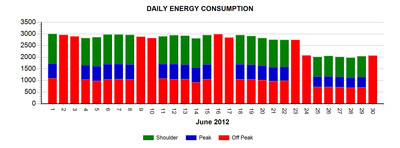Retrofit realises rebates
Monday, 10 December, 2012
The Abode Apartments complex is located in the commercial hub of St Leonards on Sydney’s North Shore. The development was completed in 2004 and is home to around 600 residents. With accommodation spanning two towers - the 18-storey West Tower and 10-storey East tower - the premium development includes190 apartments, secure underground parking, a gym, a swimming pool and a spa/wellness centre.
In early 2012, LED lighting experts enLighten Australia were completing a retrofit lighting installation in a neighbouring strata property when the Abode Executive Committee was considering ways to increase energy efficiency across the development. enLighten was consequently awarded a contract to supply LED lighting in the fire stairs and underground carpark in May 2012.
In addition, the executive committee embarked on a program of building-wide energy reduction which included power factor correction implementation, installation of LED downlights in the front-of-house corridor areas and heat pumps for the pool.
enLighten’s charter was simple: save energy. Existing lighting in the fire stairs was a mixture of 36 W single and double T8 fluorescent fixtures driven by electronic and magnetic ballasts. The lights need to operate 24 hours a day, 7 days a week and included no energy-saving controls. The majority of car park lighting was fitted with occupancy sensors.
As the fire stairs were extremely low-use areas that accessed each of the tower floors, as well as the car park, enLighten determined that the most appropriate fitting was the Chamaeleon, which operates on a standby level of light during periods when the area is unoccupied. The average standby energy usage is 7.5 W, which increases to 28 W when presence is detected via a microwave sensor.
In total, 452 fluorescent tubes were replaced with 271 Chamaeleon lights, generating lighting levels above Australian standards.
Ceiling-mounted emergency 10 chip Chamaeleon fittings were installed in the fire stair areas, which required 24-hour lighting, and a mixture of standard and emergency Chamaeleons were installed in the car park.

The Chamaeleon fittings are particularly suitable to low occupancy areas, as the integrated microwave sensor detects motion and raises light levels accordingly, thereby saving energy in standby mode. Installation has clearly been a key consideration in the design process, as many of the elements address problems common to fittings of this type including: a ‘smart’ connection base facilitates easy installation and removal for maintenance and technology upgrades, a keyed lock for fast and easy removal of the fixture without power isolation, an externally accessible compartment for simple battery changeover (in emergency versions). The Chaemeleon also incorporates generous integrated heatsink, which maximises LED performance and supports a life span of up to 50,000 h.
Energy savings on the project were immediately evident, as the graph below illustrates. Energy use post-installation (24 June) shows a reduction of 25%. ROI was calculated by costing maintenance access, the number of lamps and control components replaced including ballasts, starters and transformers, disposal and emergency battery costs.

Estimated per annum electricity savings are projected at 138,771 kWh, or an astounding 91%. Given that the project will be applicable for Energy Savings Certificates under the NSW Energy Savings Scheme, the project will realise an ROI period of around 1.6 years.
Tackling EV misinformation at Everything Electric
Lauren Davis discusses all things EV with Robert Llewellyn, Red Dwarf cast member...
Let's talk about electrification, digitalisation and decarbonisation
Can the building sector use AI tools as a binding force for different energy efficiency processes?
A connected world: how smart systems are enhancing sustainability
The drive for smarter, smoother, more efficient connected and integrated infrastructure is often...




